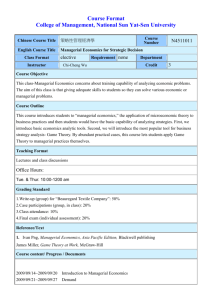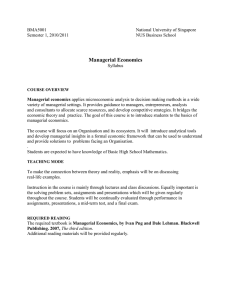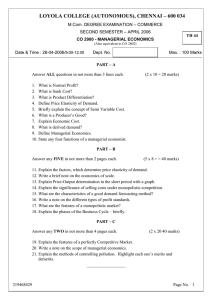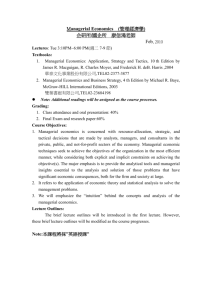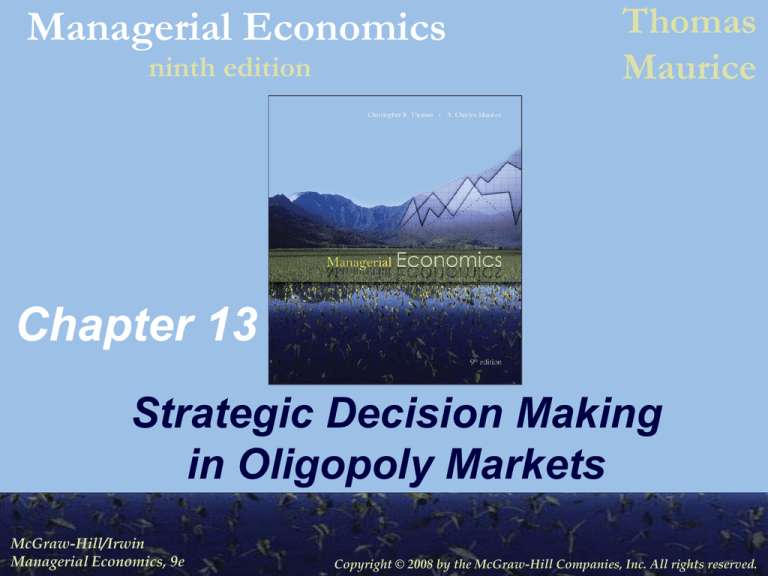
Managerial Economics
ninth edition
Thomas
Maurice
Chapter 13
Strategic Decision Making
in Oligopoly Markets
McGraw-Hill/Irwin
McGraw-Hill/Irwin
Managerial
ManagerialEconomics,
Economics,9e
9e
Copyright © 2008 by the McGraw-Hill Companies, Inc. All rights reserved.
Managerial Economics
Oligopoly Markets
• Interdependence of firms’ profits
• Distinguishing feature of oligopoly
• Arises when number of firms in
market is small enough that every
firms’ price & output decisions affect
demand & marginal revenue conditions
of every other firm in market
13-2
Managerial Economics
Strategic Decisions
• Strategic behavior
• Actions taken by firms to plan for &
react to competition from rival firms
• Game theory
• Useful guidelines on behavior for
strategic situations involving
interdependence
13-3
Managerial Economics
Simultaneous Decisions
• Occur when managers must make
individual decisions without
knowing their rivals’ decisions
13-4
Managerial Economics
Dominant Strategies
• Always provide best outcome no matter
what decisions rivals make
• When one exists, the rational decision
maker always follows its dominant
strategy
• Predict rivals will follow their dominant
strategies, if they exist
• Dominant strategy equilibrium
• Exists when when all decision makers have
dominant strategies
13-5
Managerial Economics
Prisoners’ Dilemma
• All rivals have dominant strategies
• In dominant strategy equilibrium,
all are worse off than if they had
cooperated in making their
decisions
13-6
Managerial Economics
Prisoners’ Dilemma (Table 13.1)
Bill
Don’t confess
Don’t
confess
Jane
B
2 years, 2 years
C
Confess
13-7
A
Confess
J
1 year, 12 years
B
12 years, 1 year
D
JB
6 years, 6 years
Managerial Economics
Dominated Strategies
• Never the best strategy, so never would
be chosen & should be eliminated
• Successive elimination of dominated
strategies should continue until none
remain
• Search for dominant strategies first,
then dominated strategies
• When neither form of strategic dominance
exists, employ a different concept for
making simultaneous decisions
13-8
Managerial Economics
Successive Elimination of
Dominated Strategies (Table 13.3)
Palace’s price
High ($10)
High
($10)
Castle’s
price
Medium
($8)
Low
($6)
Medium ($8)
A
$1,000, $1,000
C
B
$900, $1,100
C P
C
$500, $1,200
D
$1,100, $400
E
P
$800, $800
F
$450, $500
C
G
$1,200, $300
H
$500, $350
I
Payoffs in dollars of profit per week.
13-9
Low ($6)
P
$400, $400
Managerial Economics
Successive Elimination of
Dominated Strategies (Table 13.3)
Unique
Palace’s price Solution
Reduced Payoff
Table
Medium ($8)
Castle’s
price
High
($10)
Low
($6)
Low ($6)
C
B
$900, $1,100
C
CP
$500, $1,200
H
$500, $350
I
P
$400, $400
Payoffs in dollars of profit per week.
13-10
Managerial Economics
Making Mutually Best Decisions
• For all firms in an oligopoly to be
predicting correctly each others’
decisions:
• All firms must be choosing individually
best actions given the predicted
actions of their rivals, which they can
then believe are correctly predicted
• Strategically astute managers look for
mutually best decisions
13-11
Managerial Economics
Nash Equilibrium
• Set of actions or decisions for
which all managers are choosing
their best actions given the actions
they expect their rivals to choose
• Strategic stability
• No single firm can unilaterally make a
different decision & do better
13-12
Managerial Economics
Super Bowl Advertising: A Unique
Nash Equilibrium (Table 13.4)
Pepsi’s budget
Low
C
A
D
Medium
P
C
C
F
$45, $35
$65, $30
H
$45, $10
High
P
$57.5, $50
E
$50, $35
G
High
B
$60, $45
Low
Coke’s
budget
Medium
$30, $25
I
$60, $20
C P
$50, $40
Payoffs in millions of dollars of semiannual profit.
13-13
Managerial Economics
Nash Equilibrium
• When a unique Nash equilibrium set of
decisions exists
• Rivals can be expected to make the
decisions leading to the Nash equilibrium
• With multiple Nash equilibria, no way to
predict the likely outcome
• All dominant strategy equilibria are also
Nash equilibria
• Nash equilibria can occur without dominant
or dominated strategies
13-14
Managerial Economics
Best-Response Curves
• Analyze & explain simultaneous
decisions when choices are continuous
(not discrete)
• Indicate the best decision based on the
decision the firm expects its rival will
make
• Usually the profit-maximizing decision
• Nash equilibrium occurs where firms’
best-response curves intersect
13-15
Managerial Economics
Bravo Airway’s quantity
Arrow Airline’s price
Panel A –
Arrow believes PB =
$100
Arrow Airline’s price and
marginal revenue
Deriving Best-Response Curve
for Arrow Airlines (Figure 13.1)
Panel B – Two points on
Arrow’s best-response
curve
13-16
Bravo Airway’s price
Managerial Economics
Arrow Airline’s price
Best-Response Curves & Nash
Equilibrium (Figure 13.2)
13-17
Bravo Airway’s
price
Managerial Economics
Sequential Decisions
• One firm makes its decision first,
then a rival firm, knowing the
action of the first firm, makes its
decision
• The best decision a manager makes
today depends on how rivals respond
tomorrow
13-18
Managerial Economics
Game Tree
• Shows firms decisions as nodes with
branches extending from the nodes
• One branch for each action that can be
taken at the node
• Sequence of decisions proceeds from left to
right until final payoffs are reached
• Roll-back method (or backward
induction)
• Method of finding Nash solution by looking
ahead to future decisions to reason back to
the current best decision
13-19
Managerial Economics
Sequential Pizza Pricing
(Figure 13.3)
Panel B – Roll-back
solution
13-20
Managerial Economics
First-Mover & Second-Mover
Advantages
• First-mover advantage
• If letting rivals know what you are
doing by going first in a sequential
decision increases your payoff
• Second-mover advantage
• If reacting to a decision already made
by a rival increases your payoff
13-21
Managerial Economics
First-Mover & Second-Mover
Advantages
• Determine whether the order of
decision making can be confer an
advantage
• Apply roll-back method to game trees
for each possible sequence of
decisions
13-22
Managerial Economics
First-Mover Advantage in
Technology Choice (Figure 13.4)
Motorola’s technology
Analog
SM B
A
$10, $13.75
Analog
Sony’s
technology
C
Digital
Digital
$9.50, $11
$8, $9
SM
D
$11.875, $11.25
Panel A – Simultaneous technology decision
13-23
Managerial Economics
First-Mover Advantage in
Technology Choice (Figure 13.4)
Panel B – Motorola secures a first-mover
advantage
13-24
Managerial Economics
Strategic Moves
• Actions used to put rivals at a
disadvantage
• Three types
• Commitments
• Threats
• Promises
• Only credible strategic moves
matter
13-25
Managerial Economics
Commitments
• Managers announce or
demonstrate to rivals that they will
bind themselves to take a
particular action or make a specific
decision
• No matter what action or decision is
taken by rivals
13-26
Managerial Economics
Threats & Promises
• Conditional statements
• Threats
• Explicit or tacit
• “If you take action A, I will take
action B, which is undesirable or costly
to you.”
• Promises
• “If you take action A, I will take
action B, which is desirable or
rewarding to you.”
13-27
Managerial Economics
Cooperation in Repeated
Strategic Decisions
• Cooperation occurs when
oligopoly firms make individual
decisions that make every firm
better off than they would be in a
(noncooperative) Nash equilibrium
13-28
Managerial Economics
Cheating
• Making noncooperative decisions
• Does not imply that firms have made
any agreement to cooperate
• One-time prisoners’ dilemmas
• Cooperation is not strategically stable
• No future consequences from
cheating, so both firms expect the
other to cheat
• Cheating is best response for each
13-29
Managerial Economics
Pricing Dilemma for AMD & Intel
(Table 13.5)
AMD’s price
High
Low
A: Cooperation
High
$5, $2.5
Intel’s
price
B: AMD cheats
$2, $3
A
C: Intel cheats
Low
$6, $0.5
D: Noncooperation
$3, $1
I
I A
Payoffs in millions of dollars of profit per week.
13-30
Managerial Economics
Punishment for Cheating
• With repeated decisions, cheaters
can be punished
• When credible threats of
punishment in later rounds of
decision making exist
• Strategically astute managers can
sometimes achieve cooperation in
prisoners’ dilemmas
13-31
Managerial Economics
Deciding to Cooperate
• Cooperate
• When present value of costs of cheating
exceeds present value of benefits of
cheating
• Achieved in an oligopoly market when all
firms decide not to cheat
• Cheat
• When present value of benefits of
cheating exceeds present value of costs
of cheating
13-32
Managerial Economics
Deciding to Cooperate
PVBenefits of cheating
B1
B2
BN
...
1
2
(1 r ) (1 r )
( 1 r )N
Where Bi Cheat Cooperate for i 1, ..., N
PVCosts of cheating
C1
C2
CP
...
N 1
N 2
(1 r )
(1 r )
( 1 r )N P
Where C j Cooperate Nash for j 1, ..., P
13-33
Managerial Economics
A Firm’s Benefits & Costs of
Cheating (Figure 13.5)
13-34
Managerial Economics
Trigger Strategies
• A rival’s cheating “triggers”
punishment phase
• Tit-for-tat strategy
• Punishes after an episode of cheating
& returns to cooperation if cheating
ends
• Grim strategy
• Punishment continues forever, even if
cheaters return to cooperation
13-35
Managerial Economics
Facilitating Practices
• Legal tactics designed to make
cooperation more likely
• Four tactics
•
•
•
•
13-36
Price matching
Sale-price guarantees
Public pricing
Price leadership
Managerial Economics
Price Matching
• Firm publicly announces that it will
match any lower prices by rivals
• Usually in advertisements
• Discourages noncooperative pricecutting
• Eliminates benefit to other firms from
cutting prices
13-37
Managerial Economics
Sale-Price Guarantees
• Firm promises customers who buy
an item today that they are entitled
to receive any sale price the firm
might offer in some stipulated
future period
• Primary purpose is to make it costly
for firms to cut prices
13-38
Managerial Economics
Public Pricing
• Public prices facilitate quick
detection of noncooperative price
cuts
• Timely & authentic
• Early detection
• Reduces PV of benefits of cheating
• Increases PV of costs of cheating
• Reduces likelihood of noncooperative
price cuts
13-39
Managerial Economics
Price Leadership
• Price leader sets its price at a level
it believes will maximize total
industry profit
• Rest of firms cooperate by setting
same price
• Does not require explicit
agreement
• Generally lawful means of facilitating
cooperative pricing
13-40
Managerial Economics
Cartels
• Most extreme form of cooperative
oligopoly
• Explicit collusive agreement to
drive up prices by restricting total
market output
• Illegal in U.S., Canada, Mexico,
Germany, & European Union
13-41
Managerial Economics
Cartels
• Pricing schemes usually strategically
unstable & difficult to maintain
• Strong incentive to cheat by lowering price
• When undetected, price cuts occur
along very elastic single-firm demand
curve
• Lure of much greater revenues for any one
firm that cuts price
• Cartel members secretly cut prices causing
price to fall sharply along a much steeper
demand curve
13-42
Managerial Economics
Intel’s Incentive to Cheat
(Figure 13.6)
13-43
Managerial Economics
Tacit Collusion
• Far less extreme form of
cooperation among oligopoly firms
• Cooperation occurs without any
explicit agreement or any other
facilitating practices
13-44
Managerial Economics
Strategic Entry Deterrence
• Established firm(s) makes strategic
moves designed to discourage or
prevent entry of new firm(s) into a
market
• Two types of strategic moves
• Limit pricing
• Capacity expansion
13-45
Managerial Economics
Limit Pricing
• Established firm(s) commits to
setting price below profitmaximizing level to prevent entry
• Under certain circumstances, an
oligopolist (or monopolist), may make a
credible commitment to charge a lower
price forever
13-46
Managerial Economics
Limit Pricing: Entry Deterred
(Figure 13.7)
13-47
Managerial Economics
Limit Pricing: Entry Occurs
(Figure 13.8)
13-48
Managerial Economics
Capacity Expansion
• Established firm(s) can make the threat
of a price cut credible by irreversibly
increasing plant capacity
• When increasing capacity results in
lower marginal costs of production, the
established firm’s best response to
entry of a new firm may be to increase
its own level of production
• Requires established firm to cut its price to
sell extra output
13-49
Managerial Economics
Excess Capacity Barrier to Entry
(Figure 13.9)
13-50
Managerial Economics
Excess Capacity Barrier to Entry
(Figure 13.9)
13-51

